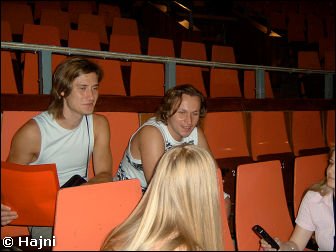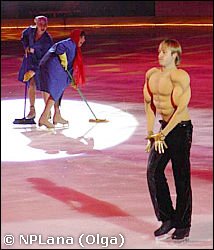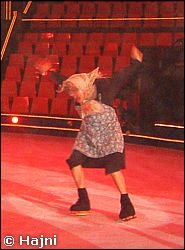The wonderful circus on ice; Alexei and Dimitrij speaking
Text
by Helga Dobor
Photos © Hajni
& Helga Dobor
Hungarian
version available. Click here!
 |
You have probably already read our previously published Circus on Ice report. We had a great time visiting the show and it was very entertaining. Afterwards we had the opportunity to talk to the choreographers, Dimitrij Mokricin and Alexei Zheleznjakov. They have been with the show since last year, and together with the artists they did a fabulous job. |
We had never seen a show like this one, and for figure skating fans it was something very different! However, we learned that about 25 years ago, a similar team toured Budapest. Perhaps some of the parents of the children visiting now saw the show back then. We soon discovered that “The Wonderful Iceworld” is a very entertaining show, not only for children but also for adults. We liked it very much. We had lots of questions to ask the choreographers, but the interview soon took on a different direction than we had planned beforehand, and new and interesting issues arose. So although some of our questions may have remained unanswered, we did get a lot of insight into the circus on ice.
In Hungary this may be an unusual kind of show, but in Russia
there are more circuses performing on ice. This particular
circus originates from Moscow, “it’s the Moscow
State Circus, but on ice”, Alexei and Dimitrij
informed us. As the show consists of a big team of artists
and skaters, one of the first things we asked was how such
a group got put together.
“Our manager invited the people for us, so when
we started to work with them, they already had a complete
team ready. But with such a big group, people are always coming
and going, so this already isn’t the original cast anymore.
Lots of members get injured, so that's why the manager of
the show does the casting of the performers.”
|
 |
Although working on a show like this is a huge task, Alexei
and Dimitrij kind of found their niche by accident.
“We fell into this job. The director, Janna Sevchenko,
invited us to the circus. We started to work as choreographers,
at first we made some choreography for the programs off ice
and when the manager liked our ideas, we could start to try
these parts on ice too.”
Although adults, most of us are still kids at heart, or at
least there is a child in every family. When people think
about Russia, the first sport that comes to mind is figure
skating, and other ice related sports. In Russia these sports
are very popular. So putting the kids and the ice together
seems to be a very lucky match, one could even say success
is guaranteed.
“Figure skating is very popular, and people really
like the combination of skating and circus. I think it’s
because it gets very spectacular, the ice and the fire, the
special costumes, the movements, the flowing clothes, the
speed, the energy and the flair… It’s the enchantment
of it all that creates the image."
The show has a perfect combination of the artistry and athleticism of skating, and the artistry and acrobatics of a circus acts. Combining ice and fire; two opposites. Both fields are very different, and the show displays that as well as the similarities. The trick must be finding performers who can manage both. Are they skaters who have learned to be acrobats? Or are they acrobats/artists who have learned to skate? We had to ask.
“We all come from different fields, and not everyone could skate before joining the show. Some of us started skating on our own, some are professional skaters and some were artists who learned to skate when they joined the show. There is another show named Circus on Ice in Russia, and we have imported some skaters from this group. We have also invited skaters from children’s companies." |
 |
The skaters among them seem to be very professional ones,
and they are excellent artists as well. We could easily imagine
some of them having a past in competitive figure skating.
“Yes, two people in the team skated professional
before. But mostly they are coaches, professional coaches
who worked in this field and skated too of course, and they
studied in the University of Physical Education. They took
up coaching children and adult skaters. Mostly we don't have
professional skaters on the ice because the professional icerink
is usually bigger and there the skaters have space to get
enough speed to jump. On our surface they don’t, their
talent and skating can't be worked out here. That's why you
can't see more professionals, they wouldn't be able to show
their talent in this show."
The skaters in the group seem to be very professional ones,
and they are excellent artists as well. We could easily imagine
some of them having a past in competitive figure skating.
“Yes, two people in the team skated professionally
before. But mostly they are professional coaches who worked
in this field and skated too, and they studied Physical Education
at the University. They took up coaching children and adult
skaters. Mostly we don't have eligible/professional skaters
on the ice since an Olympic icerink is bigger and the skaters
have space to get enough speed to jump. On our surface they
don’t, which is why you don't see more professionals,
they wouldn't be able to show their full talent in this show."
So it’s a very mixed company consisting of acrobats,
skaters and artists. People have to be able to master all
three elements to perform in this show. But it’s also
hazardous, and some acts are extremely tricky. And as mentioned
before, the cast often varies because of (amongst other things)
injuries. Thus the combining of elements not only make the
show special, but it increases the risks as well! We had the
feeling almost every act was very dangerous, but of course
we are no expert in these matters...
“The most dangerous parts are when the artists are in
the air! When they land, for example on the shoulders of their
partners, the blades always cause some small cuts. These landings
are already very painful without skates, but when the air-acrobats
wear skates, the pain is even worse. We call these injuries
‘piggy bank cuts’. And another danger
is the ice itself, because we jump on it, we ride bicycles
on it (with skates! – ed.), and do other things too.
And of course, the quality of the ice gets worse by the minute,
so the artists can tumble down and fall easily. There are
lots of mistakes to be made on the ice, and accidents can
happen. You can see now how bad it is at the end!”
We are shown the ice. It’s ice resurfacing time,
and a man is doing it with a hand rolba. The result isn’t
perfect.
“The ice is not the same as in figure skating competitions,
it is more dangerous here, and we only have a very small surface.”

One would think that the choreography consists of only creating
the acts, but the opposite is true. Alexei and Dimitrij work
with the group on a daily basis.
“We give instructions continuously. We came here
with the team and we will leave at the same time too.”
With so many potential mishaps and injuries, it must be impossible
to run a show without great flexibility and a back-up plan.
“This show has more performances with many acts.
All of them have their own choreography, so if anyone would
be injured, only the number of artists change. But if the
artist is part of a duo, we replace him with another artist.
It is easy to do this, because they have all learned the choreography
of each other, and not only their own.”
We witnessed some figure skating moves used only by elite
skaters, because they are very difficult, for example: Biellmann
spins, death spirals and headbangers. The terms come from
figure skating but are also used in this company.
“Of course, yes, we know these expressions! Those
coming from non-skating fields had to learn these words, and
of course the choreographers and directors know them. By using
these words they can explain to the artists what they want
to see on the ice. It’s essential to have a common language,
without it they can’t make themselves understood.”



Some 'ghosts' performing the above mentioned moves
The capital of Hungary, Budapest, has an International Circus
Festival every year, and it’s becoming a very popular
festival, not only here and in Europe, but worldwide. But
Hungary isn’t the only country the company has toured.
“We have performed in more countries in Europe;
like France and Romania. We are hardly ever at home because
of the continuous touring; we haven’t been home in almost
a year now! Luckily the team of artists is young, so it’s
not that hard for us.”
This answer raised an interesting issue we always wanted to
know the answer to, and supposingly we are not alone. If hardly
ever at home, except for a few days a year, what is considered
“home” anyway? And what are the possibilities
of having any kind of personal life?
“Of course we have a private life, but to keep the
connection with our loved ones is not easy.” Alexei
explains. “Neither of us was born in Moscow, but
I live there while my family still lives in my hometown. All
my friends and colleagues live in Moscow as well as my girlfriend...”
Usually show- and circus companies have members from more
than one country. But this circus, the Moscow State Circus,
seems like a real Russian team.
“We are all from the former Soviet union, but not
everyone is Russian. There are artists from the Ukraine and
Kazakhstan too.” Dimitrij adds “and I'm
from Moscow.”
When visiting so many countries, chances are you develop favorites.
Places you love or countries where you want to stay forever.
The company has been staying in Budapest since March; one
of the most beautiful capitals in Europe.
“We like Budapest very much! The people here are
friendly and warm-hearted. Yesterday when we were walking
around in the city, some of the artists told me they’d
like to stay here, they love this city.”
But unfortunately they won’t stay forever. The show
must move on and it will.
“Our last performance is on the 28th of August,
and we will leave on the 29th. We have a bit of time to relax,
10 days, and then the work starts again, in Romania this time.”
We had come to the conclusion of this
interview, but we couldn’t leave without asking
Alexei and Dimitrij about our own passion – figure
skating. After all, the circus comes from Moscow, Russia
where skating has such a rich past and present. Surely
even circus people would know something about it. |
 |
“Let me think”, smiles Dimitrij.
“Eeevgeeeeniii Pluuuusheeenkooo!” (He holds
the vowels and pronounces the name with reverence)
“Same here”, Alexei replies.
“He is the best”, adds Dimitrij.
Laughs all around as we agree.
“He skates not only professionally, but he’s
a good artist too! For us not only the good skating is important,
but we have to feel the artist blood in the skating! And he
has it!”
We think we know the answer to the last question, but still...
Would you invite him - if it were possible - to perform in
a show?
“Yes, of course, there is no question about it!
What’s the most important to an artist is that he is
able to win the love of the audience, and Plushenko surely
is! “
On this note we had to leave and head for home. Thank
you very much Alexei and Dimitrij for taking the time to answer
our questions. We wish you a terrific time for the remaining
of your stay in Hungary!





